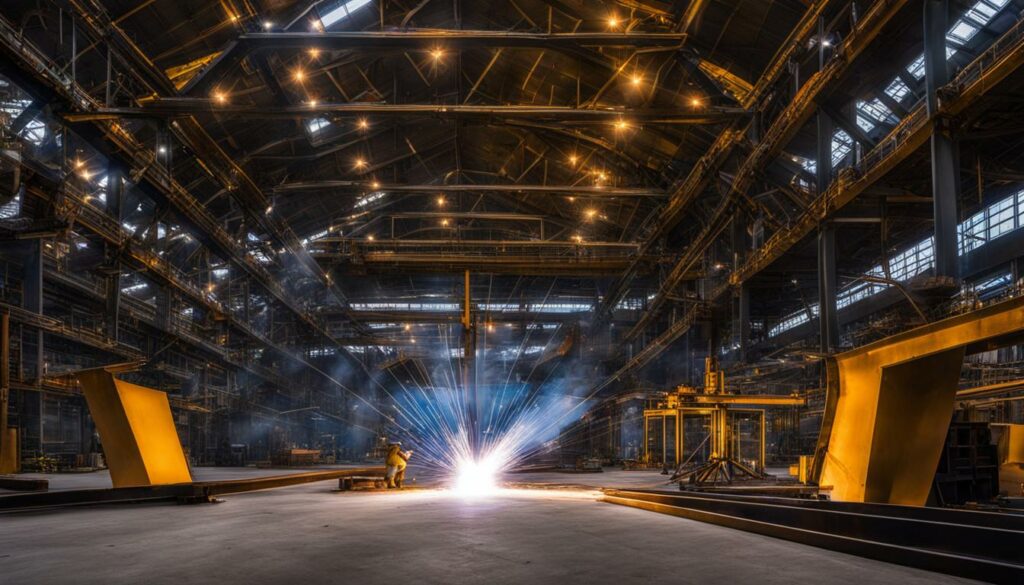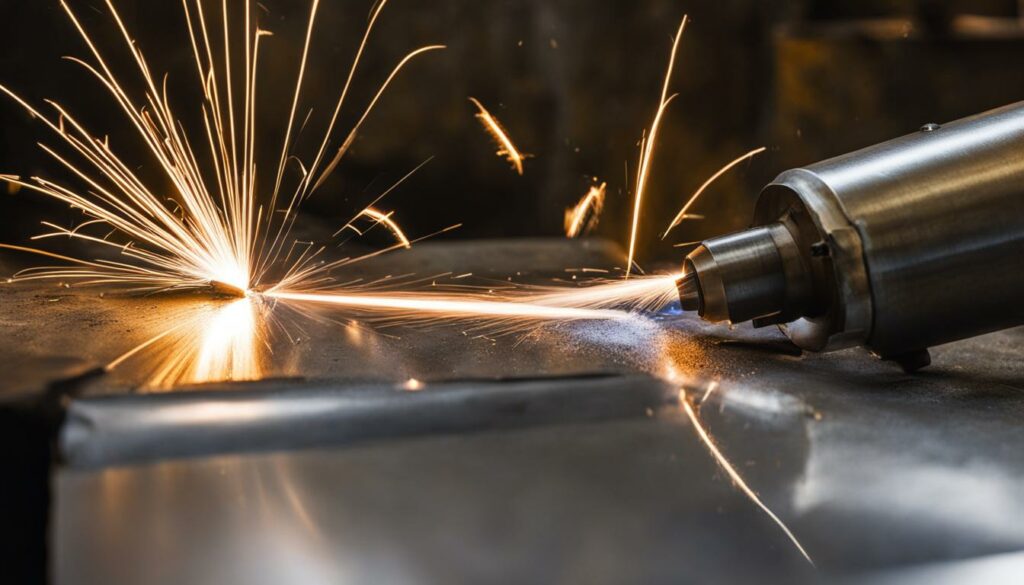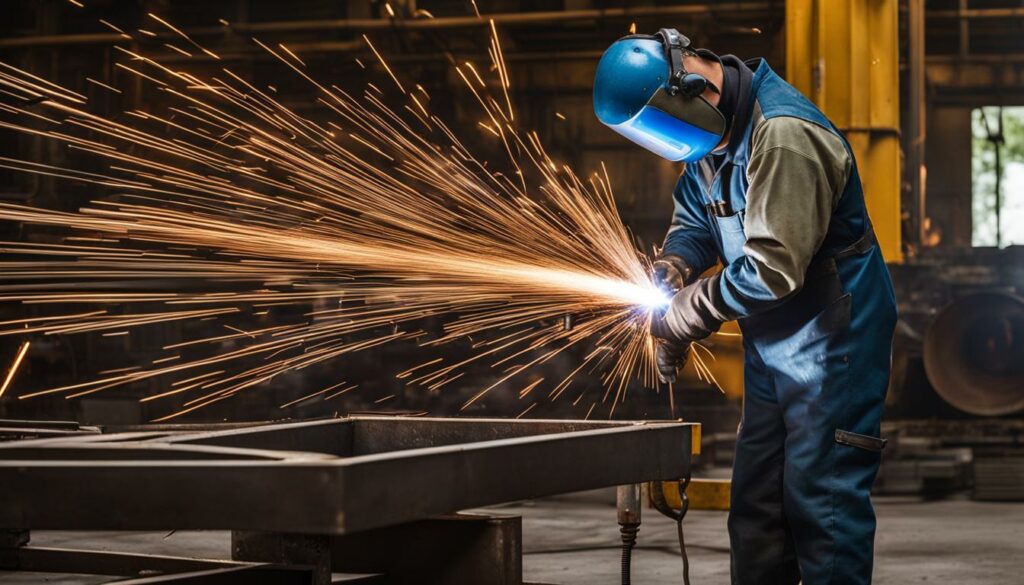Welding is a critical process in structural steel fabrication, allowing for the creation of durable and precise connections between steel components. To achieve the highest level of quality and strength, it is essential to explore advanced structural welding techniques. Whether you are a professional welder or simply interested in understanding the intricacies of welding, this article will provide an overview of different welding techniques, their applications, and factors to consider when choosing the right technique for your project.
Key Takeaways:
- Advanced structural welding techniques play a crucial role in ensuring precision and strength in structural steel fabrication.
- Common welding techniques include MIG welding, TIG welding, Stick welding, Flux welding, Energy Beam Welding, Atomic Hydrogen Welding, Oxy-acetylene Welding, and Plasma Arc Welding.
- The choice of welding technique depends on factors such as material, project requirements, and skill level.
- Quality assurance measures, including regular inspections and testing, are important to ensure weld integrity.
- Advanced welding courses provide opportunities to enhance welding skills and master structural welding techniques.
The Importance of Welding in Structural Steel Fabrication

Structural steel fabrication plays a vital role in the construction industry, providing the framework for buildings, bridges, and other large structures. Welding, in particular, is a critical component of this process, as it allows individual steel components to be joined together to form a unified structure with the required strength and precision.
Welding ensures that the fabricated steel structures possess the necessary rigidity and durability to withstand various loads and environmental conditions. By effectively bonding steel components, welding creates continuous joints that distribute stress evenly, enhancing the overall strength and stability of the structure.
Furthermore, welding enables the fabrication of complex and intricate designs that fulfill architectural and engineering requirements. With different welding techniques available, such as MIG welding, TIG welding, and flux-cored arc welding, fabricators can choose the most suitable method based on factors like material thickness, joint configuration, and welding position.
Advantages of Welding in Structural Steel Fabrication:
- Provides strength and rigidity to fabricated steel structures
- Creates continuous joints that distribute stress evenly
- Enables the fabrication of complex and intricate designs
- Allows for customization based on project requirements
Welding is an indispensable process in structural steel fabrication, as it ensures the precision, strength, and longevity of the fabricated steel structures.
By recognizing the importance of welding in structural steel fabrication and leveraging the right welding techniques, fabricators can achieve exceptional results that meet the highest quality standards.
| Welding Technique | Advantages | Applications |
|---|---|---|
| Shielded Metal Arc Welding (SMAW) | Portability, versatility | Construction, maintenance |
| Gas Metal Arc Welding (GMAW or MIG welding) | High productivity, clean welds | Automotive, manufacturing |
| Flux-Cored Arc Welding (FCAW) | Deep penetration, all-position welding | Shipbuilding, heavy equipment |
| Submerged Arc Welding (SAW) | High deposition rates, deep penetration | Pressure vessel, pipe welding |
| Tungsten Inert Gas Welding (TIG welding) | Excellent weld appearance, precise control | Aerospace, food industry |
Common Welding Techniques in Structural Steel Fabrication
In structural steel fabrication, different welding techniques are utilized to join steel components and create sturdy structures. Understanding these common welding techniques is important for successful fabrication projects. Let’s explore some of the most widely used methods:
1. Shielded Metal Arc Welding (SMAW)
Shielded Metal Arc Welding, also known as stick welding, is a versatile technique suitable for various applications. It involves the use of a consumable electrode coated in flux. The flux creates a gas shield around the weld, protecting it from contaminants and atmospheric conditions. SMAW is commonly used for outdoor projects and can weld thick materials.
2. Gas Metal Arc Welding (GMAW)
Gas Metal Arc Welding, often referred to as MIG welding, utilizes a continuous wire electrode and a shielding gas. The gas protects the weld pool from oxidation, ensuring high-quality welds. GMAW is renowned for its efficiency and speed, making it suitable for both thick and thin materials. It is widely used in industries such as automotive, construction, and manufacturing.
3. Flux-Cored Arc Welding (FCAW)
Flux-Cored Arc Welding is similar to GMAW but employs a tubular wire electrode filled with flux. The flux reacts with the welding arc to produce a protective gas shield. This technique is commonly used in outdoor and windy conditions because the flux provides additional protection against contaminants. FCAW is suitable for welding thicker materials and is often used in shipbuilding, construction, and structural fabrication.
4. Submerged Arc Welding (SAW)
Submerged Arc Welding is an automated process that submerges the electrode and weld area in a granular flux. The flux blankets the arc, preventing atmospheric contamination and enhancing the weld quality. SAW is known for its productivity and ability to weld thick sections. It is commonly used in heavy fabrication, such as the production of pressure vessels, bridges, and offshore structures.
5. Tungsten Inert Gas Welding (TIG)
Tungsten Inert Gas Welding, also known as GTAW, uses a non-consumable tungsten electrode and an inert gas, typically argon, to create a protective atmosphere. TIG welding produces high-quality, precise welds with excellent aesthetics. It is commonly used for thin materials, stainless steel, aluminum, and critical applications that require exceptional weld integrity.
By understanding and selecting the appropriate welding technique based on project requirements, material thickness, and joint configuration, you can ensure successful structural steel fabrication. Each welding method offers unique advantages and applications, and consulting with welding professionals can help you make informed decisions for your specific project.
Choosing the Right Welding Technique for Your Project
When it comes to structural welding, selecting the right welding technique is crucial to ensure the success of your project. The choice of technique depends on several factors, including project requirements, material thickness, joint configuration, and welding position. By considering these factors and consulting with welding professionals, you can determine the most suitable technique for your specific application.
Project requirements play a significant role in determining the welding technique. Different projects may have varying welding needs, such as the desired aesthetic appearance, strength requirements, or specific industry regulations. By understanding and evaluating these requirements, you can narrow down the available techniques that align with your project goals.
Material thickness, joint configuration, and welding position are additional factors to consider. Certain welding techniques are better suited for thicker materials, while others are more suitable for thinner ones. Similarly, the joint configuration and welding position can influence the choice of technique, as some techniques are better suited for specific joint types or welding positions.
Table: Welding Techniques Comparison
| Welding Technique | Advantages | Applications |
|---|---|---|
| Shielded Metal Arc Welding (SMAW) | Durable and versatile | Construction, maintenance, pipelines |
| Gas Metal Arc Welding (GMAW or MIG welding) | Fast and efficient | Automotive, fabrication, manufacturing |
| Flux-Cored Arc Welding (FCAW) | Deep penetration and high deposition rates | Shipbuilding, heavy equipment, construction |
| Submerged Arc Welding (SAW) | High welding speeds and excellent weld quality | Pipeline, pressure vessel, structural steel |
| Tungsten Inert Gas Welding (TIG welding) | Precise and creates clean welds | Aerospace, automotive, stainless steel |
By referring to the table above, you can get a quick overview of the advantages and applications of various welding techniques. This comparison can help you make an informed decision based on the specific requirements of your project.
Remember, choosing the right welding technique requires careful consideration of project requirements, material thickness, joint configuration, and welding position. By selecting the most suitable technique, you can ensure the quality, strength, and durability of your welds, resulting in a successful structural welding project.
Quality Assurance in Welding for Structural Steel Fabrication
Quality assurance is a critical aspect of welding in structural steel fabrication. It ensures that the welds meet the required standards and specifications, resulting in reliable and durable structures. To achieve this, various measures are implemented throughout the welding process.
Welding Inspection
Welding inspection plays a vital role in quality assurance. Inspectors carefully examine the welds to ensure they meet the defined criteria, including weld size, penetration, and quality of the weld bead. They also check for any defects such as cracks, porosity, or incomplete fusion. Through comprehensive inspection, any issues can be identified and rectified early on, minimizing the risk of structural failure.
Welding Testing
In addition to inspection, welding testing is conducted to assess the weld integrity and overall quality. Non-destructive testing methods such as ultrasonic testing, radiography, and magnetic particle inspection are used to detect any internal or surface defects that may compromise the strength and integrity of the welds. These tests provide valuable insights into the quality of the welds and ensure that they meet the required standards.
Ensuring Weld Integrity
Ensuring weld integrity is a crucial aspect of quality assurance. It involves adhering to proper welding parameters, such as welding current, voltage, and travel speed, to achieve optimal weld quality. Skilled welders who are trained in advanced structural welding techniques play a significant role in maintaining weld integrity. Additionally, the selection of appropriate welding consumables, such as electrodes and shielding gases, further enhances the integrity of the welds.
| Quality Assurance Measures | Benefits |
|---|---|
| Implementing quality control procedures throughout the welding process | Minimizes the risk of defects and ensures consistent weld quality |
| Conducting regular inspections and testing of welded joints | Identifies any issues early on and prevents structural failures |
| Adhering to proper welding parameters and material selection | Ensures optimal weld quality and integrity |
| Following welding codes and standards | Ensures compliance with industry best practices and regulations |
By implementing comprehensive quality assurance measures, structural steel fabrication can achieve welds of the highest quality, ensuring the strength and durability of the fabricated structures.

Ensuring Weld Integrity in Advanced Structural Welding Techniques
When working with advanced structural welding techniques, ensuring weld integrity is of utmost importance. Proper weld integrity guarantees the strength, durability, and safety of the fabricated steel structures. To achieve this, several key factors must be considered and implemented throughout the welding process.
Skilled Welders
The expertise and proficiency of the welder play a crucial role in achieving weld integrity. Skilled welders have a deep understanding of different welding parameters, such as heat input, travel speed, and electrode positioning. They possess the necessary knowledge to adjust these parameters based on the materials being welded and the specific project requirements. Employing certified and experienced welders ensures that the welding process is executed with precision and accuracy.
Proper Welding Parameters
Accurate control of welding parameters is essential for maintaining weld integrity. These parameters, including voltage, current, and shielding gas flow rate, directly impact the quality and strength of the welds. Welding procedures should be carefully developed, taking into account the specific materials and joint configurations. Regular monitoring and adjustment of welding parameters during the welding process helps achieve optimal weld quality and integrity.
Appropriate Welding Consumables and Heat Treatment
Selecting the right welding consumables, such as electrodes and filler metals, is crucial for weld integrity. These consumables must be compatible with the base metal and the welding technique used. Additionally, proper pre-weld and post-weld heat treatment is essential to relieve residual stresses and improve the overall integrity of the weld. By carefully choosing welding consumables and implementing appropriate heat treatment processes, welders can ensure the long-term durability and reliability of the welded structures.
| Factors for Ensuring Weld Integrity | Importance |
|---|---|
| Skilled Welders | Skilled welders possess the expertise and knowledge required to execute the welding process with precision, ensuring weld integrity. |
| Proper Welding Parameters | Accurate control of welding parameters is vital to maintain weld quality and integrity, resulting in structurally sound welds. |
| Appropriate Welding Consumables and Heat Treatment | The use of compatible welding consumables and proper heat treatment processes significantly contribute to weld integrity and long-term durability. |
By prioritizing skilled welders, controlling welding parameters, and selecting appropriate welding consumables and heat treatment processes, welders can ensure weld integrity in advanced structural welding techniques. This commitment to quality and attention to detail is essential for successful and reliable structural steel fabrication.
Advanced Welding Courses for Mastering Structural Welding Techniques
If you are looking to enhance your skills in structural welding, enrolling in advanced welding courses can provide you with the necessary knowledge and hands-on training. These courses offer comprehensive instruction in various advanced welding techniques, helping you become a master in the field of structural welding.
These courses cover a range of topics, including shielded metal arc welding (SMAW), gas metal arc welding (GMAW or MIG welding), and tungsten inert gas welding (TIG welding). Through practical exercises and demonstrations, you will learn the intricacies of each technique and gain valuable experience in executing welds with precision and accuracy.
The advanced welding courses are designed to cater to both beginners and experienced welders. Whether you are just starting your journey in welding or seeking to refine your skills, these courses offer a structured learning environment that allows you to build a strong foundation and progress at your own pace.
By enrolling in advanced welding courses, you will have the opportunity to work with industry-standard equipment and learn from experienced instructors. This hands-on approach ensures that you develop the necessary skills and techniques required for successful structural welding. Upon completion of the course, you will be equipped with the expertise needed to tackle advanced welding projects and achieve superior weld quality.
So, if you are eager to take your structural welding skills to the next level, consider enrolling in advanced welding courses. These courses will provide you with the knowledge, experience, and confidence needed to excel in the field of structural welding.
Conclusion
In conclusion, mastering advanced welding techniques is crucial for successful structural steel fabrication projects. These techniques play a vital role in achieving precision, strength, and durability in welded structures. By choosing the right welding technique based on project requirements, material thickness, joint configuration, and welding position, you can ensure optimal results and structural integrity.
Implementing quality assurance measures throughout the welding process is essential to meet the required standards and specifications. Regular inspections, testing of welded joints, and adherence to welding codes and standards contribute to weld quality and integrity.
For individuals seeking to excel in the field of structural welding, advanced welding courses provide valuable hands-on training and in-depth knowledge. These courses cover a wide range of techniques, including shielded metal arc welding (SMAW), gas metal arc welding (GMAW or MIG welding), and tungsten inert gas welding (TIG welding). Mastering these techniques through professional training will enhance your welding skills and open doors to new opportunities.
FAQ
Which welding techniques are commonly used in structural steel fabrication?
Some common welding techniques used in structural steel fabrication include Shielded Metal Arc Welding (SMAW), Gas Metal Arc Welding (GMAW or MIG welding), Flux-Cored Arc Welding (FCAW), Submerged Arc Welding (SAW), and Tungsten Inert Gas Welding (TIG welding).
How do I choose the right welding technique for my project?
The choice of welding technique depends on factors such as project requirements, material thickness, joint configuration, and welding position. Consulting with welding professionals and considering these factors is crucial in selecting the most suitable technique for a specific application.
What is the importance of quality assurance in welding for structural steel fabrication?
Quality assurance is paramount in structural steel fabrication to ensure that welds meet the required standards and specifications. This includes implementing quality control procedures throughout the welding process, conducting regular inspections and testing of welded joints, and ensuring proper welding parameters, material selection, and adherence to welding codes and standards.
How can I ensure weld integrity in advanced structural welding techniques?
Achieving strong and reliable welds requires proper preparation, joint fit-up, control of welding parameters, skilled and certified welders, appropriate welding consumables, and proper pre-weld/post-weld heat treatment. These factors contribute to ensuring weld integrity in advanced structural welding techniques.
Are there advanced welding courses available for mastering structural welding techniques?
Yes, various advanced welding courses are available for individuals looking to master structural welding techniques. These courses cover topics such as shielded metal arc welding (SMAW), gas metal arc welding (GMAW or MIG welding), tungsten inert gas welding (TIG welding), and more. These courses provide hands-on training and in-depth knowledge to enhance welding skills.

